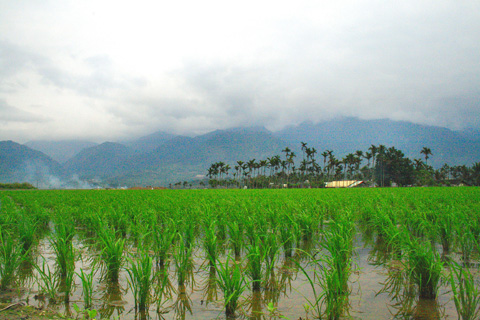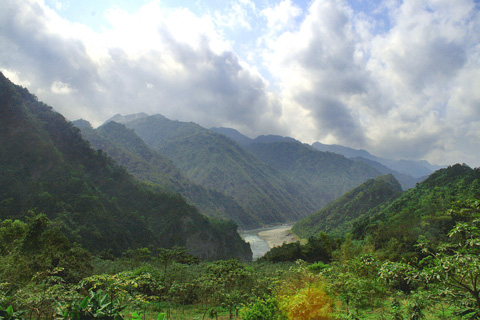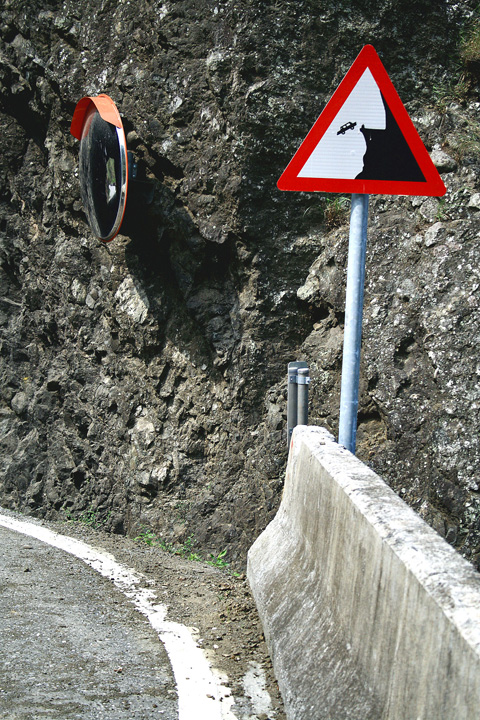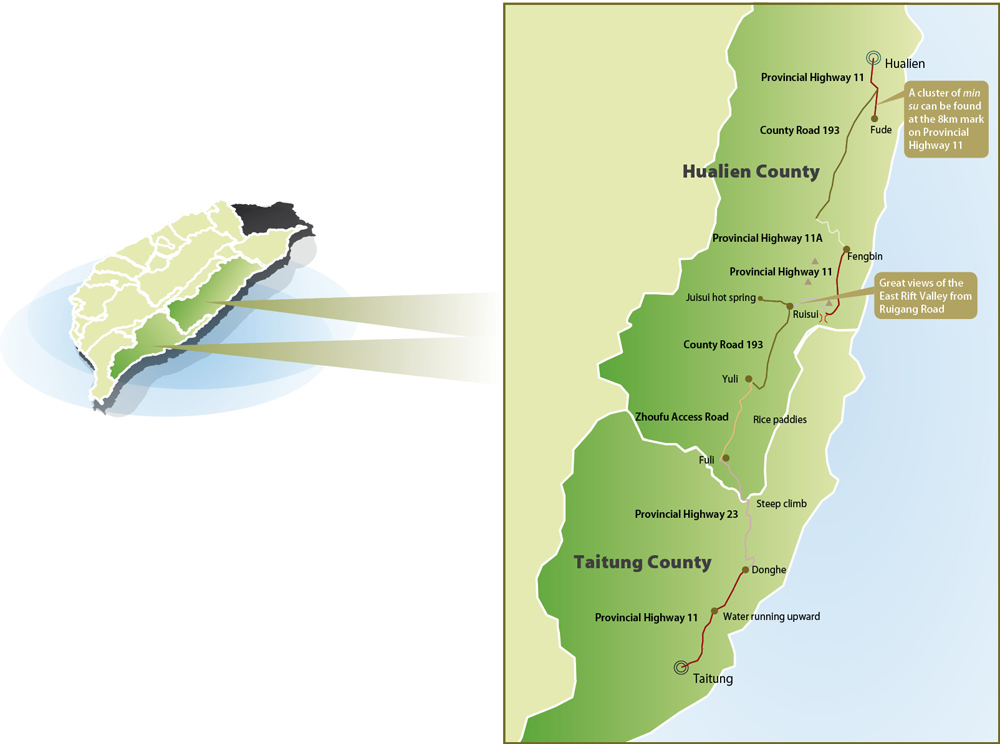A couple of weeks ago, my wife and I took the overnight train from Taipei to Taitung to ride our bicycles along the East Rift Valley (花東縱谷) up to Hualien. We didn’t want to only ride on the flats — that would not be exciting enough for us — so we decided to combine the East Rift Valley (花東縱谷) with the East Coast Highway, along with some mountain riding by crossing the Coastal Mountain Range — three times. By the evening of the second day, we had covered more than 250km in a spectacular trek that can only be called a Taiwan classic.
The route took us along sections of the gorgeous Pacific Coast Highway, where the ocean’s thundering waves crash against lush mountainous terrain. It covered the East Rift Valley, some of Taiwan’s most beautiful rural countryside. We traveled on hillside roads with views of meandering river valleys far below. The expansive East Rift Valley floor spread out before us against a backdrop of mountains. And then there were the hot springs of Ruisui (瑞穗), which provided a welcome relief for our tired legs and weary muscles.
Taitung to Ruisui

PHOTO: PERRY SVENSSON, TAIPEI TIMES
With our bikes dismantled and bagged, we left Taipei at 10:55pm on a Sunday evening and arrived in Taitung at 6:05 the next morning. After assembling our rides we went looking for a 7-Eleven. We wanted to cut several kilograms from our load by mailing the heavy bike bags ahead to Hualien, and if you know the address of the outlet where you want to pick up your shipment (more information in Chinese can be found at www.7-11.com.tw/search.asp), the cashier in any 7-Eleven in Taiwan will help you ship it there. They will even call you when it arrives.
By 8am, we were on the Zhonghua Bridge headed out of Taitung onto Provincial Road 11 toward Donghe (東河), some 40km away. After about an hour of leisurely biking along the scenic Pacific Coast Road with the mountain range tapering off into the distance ahead of us, we saw a sign that read “Water Running Upward” (水往上流) a couple of kilometers ahead of Dulan (都蘭). With a name like that, we just had to check it out; it’s easy to spot as the road signs show the name in English. It’s a narrow stream by the side of the road that, as if by some kind of illusion, does indeed appear to flow upward.
Next came Donghe, a good place to grab a snack and fill up on water since there are no shops for the entire 45km up to Fuli (富里). We then crossed the bridge outside Donghe and took an immediate left down Provincial Road 23 toward Fuli, for our first ride across the coastal mountain range.

PHOTO: PERRY SVENSSON, TAIPEI TIMES
A bit down the road, we stopped to take a look at a band of macaques sitting by the roadside. One of them wasn’t very happy that my wife, Diane, wouldn’t feed them, so she and two others attacked her. Only by dashing to our bikes and pedaling quickly away were we able to make an escape and avoid a fight.
The first 20km of Provincial Road 23 aren’t very steep, but they are followed by about 7km or 8km of continuous climbing. It might not be much steeper or higher than Wuzhishan in Taipei, but having already traveled 60km, it was still a bit trying. After this section, the inclines are less steep and mixed with a few drops before finally sloping all the way down to Fuli.
After a late lunch in Fuli, we set out for the final 50km up to Ruisui, the thought of the eagerly awaited hot springs ever clearer in our minds. We crossed the railroad to avoid the busy Provincial Road 9 and instead rode next to the green rice paddies along Zhuofu Access Road (桌富產業道路) to Yuli (玉里), where we switched to County Road 193 up to Ruisui.

PHOTO: PERRY SVENSSON, TAIPEI TIMES
In Ruisui, we stayed at Juisui Hot Spring, a place with the best kind of water, or so they say — in contrast to most hot springs we’ve been to in both Taiwan and Japan, the water is so thick with minerals that it is a brownish yellow. We were told not to shower afterwards because the minerals are good for the skin, and our skin certainly felt smoother. As expected, the soak did wonders for our sore legs.
Ruisui to Hualien

After a slow start the next day, we rolled into Ruisui at 9:30am and returned to 193 for a couple of kilometers, until we reached Township Road 64, also known as Ruigang Road (瑞港公路). Less steep and shorter than Provincial Road 23, it is a beautiful 22km ride across the mountain range back to the Pacific coast. Weaving through meandering bends above the Xiuguluan River (秀姑巒溪), it mixes dark green forest with gorgeous views down into the river valley below.
Throughout the trip, the mountain roads were almost completely empty, with that beautiful, noisy, not-so-quiet silence, or calm, you get in the mountains: birds singing, cicadas chirping, a gentle breeze, fresh air, but no man-made sounds, no matter how hard you try to detect one.
After reaching the coast at Dagangkou (大港口), we continued for another 20km to Fengbin (豐濱), where we filled up on water before taking Provincial Road 11A (11甲) toward Guangfu (光復) 19km away, to cross the mountains for the third time.
The first half of the lush and beautiful road wends its way leisurely along the Dingzilou River (丁子漏溪). Descending on the other side after crossing over the ridge, we came across a small stretch of road where there is no mountain on either side. We were riding along a narrow strip with a sheer drop on each side. It was an exhilarating feeling.
After 15km to 16km, before reaching Guangfu, we returned to County Road 193, which skirts the eastern edge of the East Rift Valley along its entire length. Here in the northern part of the valley, it flows up and down along the rolling foothills of the mountain range. There are no major climbs, but even a moderate, longish climb can be tiring after two long days. It’s worth it, though: at one moment you’re riding along next to the rice paddies and then suddenly you’re on a hill with a view of the valley.
The 193 meets the coastal highway a few kilometers south of Hualien. We turned right, and a few kilometers down the coast we hit a cluster of bed-and-breakfasts, or min su (民宿). We stopped at the first one, Blue Ocean Resort: a good clean room and a soft bed, but no dinner and a meager breakfast.
No dinner meant getting back on our bikes and rolling down the road for 5km or 6km until we found “055” — a great seafood restaurant where you choose your seafood from a counter and have beer served in a six-pack holder you keep next to you on the floor. These are always the best seafood restaurants, and this was no exception: we thoroughly enjoyed a small lobster, squid, and clams with lots of chili, garlic and basil — another Taiwan classic — together with a couple of beers.
The next morning, we rode the 14km into Hualien, where we picked up our bike bags at the 7-Eleven, then crossed the street to the railway station, where we bought tickets for the next train to Taipei. In all, we had covered 268km in an amazing two complete days and one short morning.

June 9 to June 15 A photo of two men riding trendy high-wheel Penny-Farthing bicycles past a Qing Dynasty gate aptly captures the essence of Taipei in 1897 — a newly colonized city on the cusp of great change. The Japanese began making significant modifications to the cityscape in 1899, tearing down Qing-era structures, widening boulevards and installing Western-style infrastructure and buildings. The photographer, Minosuke Imamura, only spent a year in Taiwan as a cartographer for the governor-general’s office, but he left behind a treasure trove of 130 images showing life at the onset of Japanese rule, spanning July 1897 to

In an interview posted online by United Daily News (UDN) on May 26, current Chinese Nationalist Party (KMT) Chairman Eric Chu (朱立倫) was asked about Taichung Mayor Lu Shiow-yen (盧秀燕) replacing him as party chair. Though not yet officially running, by the customs of Taiwan politics, Lu has been signalling she is both running for party chair and to be the party’s 2028 presidential candidate. She told an international media outlet that she was considering a run. She also gave a speech in Keelung on national priorities and foreign affairs. For details, see the May 23 edition of this column,

At Computex 2025, Nvidia CEO Jensen Huang (黃仁勳) urged the government to subsidize AI. “All schools in Taiwan must integrate AI into their curricula,” he declared. A few months earlier, he said, “If I were a student today, I’d immediately start using tools like ChatGPT, Gemini Pro and Grok to learn, write and accelerate my thinking.” Huang sees the AI-bullet train leaving the station. And as one of its drivers, he’s worried about youth not getting on board — bad for their careers, and bad for his workforce. As a semiconductor supply-chain powerhouse and AI hub wannabe, Taiwan is seeing

Jade Mountain (玉山) — Taiwan’s highest peak — is the ultimate goal for those attempting a through-hike of the Mountains to Sea National Greenway (山海圳國家綠道), and that’s precisely where we’re headed in this final installment of a quartet of articles covering the Greenway. Picking up the trail at the Tsou tribal villages of Dabang and Tefuye, it’s worth stocking up on provisions before setting off, since — aside from the scant offerings available on the mountain’s Dongpu Lodge (東埔山莊) and Paiyun Lodge’s (排雲山莊) meal service — there’s nowhere to get food from here on out. TEFUYE HISTORIC TRAIL The journey recommences with